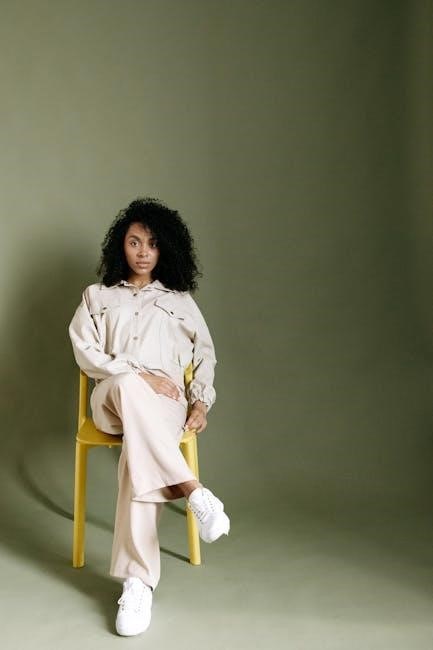Hair length guide provides general information and helps individuals understand their hair length options using a chart to determine the best style for their face shape naturally․
Understanding Hair Length Charts
Hair length charts are useful tools that help individuals understand and articulate their desired hair length and style․ They provide a reference point for people to determine their current hair length and choose a style that suits their face shape and hair type․ Hair length charts typically include general length labels for short, medium, and long hair, and can be used to track progress towards hair length goals․ By using a hair length chart, individuals can gain a better understanding of their hair and make informed decisions about their hairstyle․ This can be especially helpful for people who are looking to change their hair length or style, as it provides a clear and concise way to communicate their desires to a hair stylist․ Hair length charts can be found online or in hair salons and barber shops․ They are a valuable resource for anyone looking to understand their hair length options․

Measuring Hair Length
Measuring hair length accurately is essential for determining the right style and cut for individual hair types naturally every time using a ruler or tape measure․
Accurate Measurement Techniques
To ensure accurate measurement, start by combing your hair to remove any tangles or knots․ Then, take a ruler or tape measure and place it at the root of your hair, where it meets your scalp․ Gently pull the ruler or tape measure down to the ends of your hair, making sure to keep it straight and level․ Take note of the measurement in inches or centimeters․ It’s also important to consider the texture and thickness of your hair when measuring, as this can affect the overall length․ By using these techniques, you can get an accurate measurement of your hair length and determine the best style and cut for your individual hair type and face shape, which is essential for a great hairstyle․

Hair Length and Face Shape
Hair length and face shape are closely related to determine a suitable hairstyle naturally every time․
Choosing the Right Hair Length
To choose the right hair length, consider your face shape, hair type, and lifestyle․ A hair length chart can help you determine the best length for your features․ For example, if you have a round face, a longer hair length can help elongate your face․ If you have a square face, a shorter hair length can help soften your features․ It’s also important to consider your hair type, as some lengths may be more suitable for certain textures․ By taking these factors into account, you can choose a hair length that enhances your natural beauty and suits your lifestyle․ With the right hair length, you can feel confident and beautiful, and enjoy a hairstyle that is both stylish and low-maintenance․ This will help you make an informed decision․

Hair Length and Styling
Hair length and styling options are numerous and varied depending on individual preferences naturally․
Styling and Maintaining Different Hair Lengths
Styling and maintaining different hair lengths requires various techniques and products․ For short hair, a styling cream or pomade can add texture and definition․ Medium length hair can be styled with a round brush and blow dryer for a sleek look․ Long hair requires regular trims to prevent split ends and breakage․ A wide-tooth comb or a detangling brush can help to gently comb out tangles and knots․ Regular conditioning treatments can also help to keep hair healthy and moisturized․ Additionally, using a hair mask or deep conditioning treatment once a week can help to nourish and protect hair from damage․ By following these tips, individuals can keep their hair looking healthy and stylish, regardless of length․ Proper styling and maintenance can make a big difference in the overall appearance of hair․

Long Hair Care
Regular trims and conditioning treatments help maintain long hair health and prevent damage naturally every day․
Maintaining Long Hair
Maintaining long hair requires regular care and attention to prevent damage and breakage․ Using a wide-tooth comb or a soft-bristled brush can help to minimize tangles and knots․ Regular trims are also essential to prevent split ends and breakage․ Additionally, using a hydrating shampoo and conditioner can help to keep the hair moisturized and healthy․ It is also important to avoid using heat styling tools too frequently, as they can cause damage and dryness to the hair․ By following these tips, individuals with long hair can help to keep their hair looking healthy and vibrant, and prevent damage and breakage from occurring․ Regular maintenance is key to keeping long hair looking its best, and with the right care and attention, it can be a beautiful and luscious asset․ Proper care is essential for long hair․
Hair Length Chart Categories
Hair length chart categories include short, medium, and long hair lengths naturally․
Short, Medium, and Long Hair
The hair length guide categorizes hair lengths into short, medium, and long hair․
Short hair typically refers to hair that reaches the chin or shoulder,
while medium hair reaches the shoulder or mid-back, and long hair reaches past the mid-back․
Each category has its own unique characteristics and styling options․
Understanding these categories can help individuals choose the best hair length for their face shape and hair type․
The hair length guide provides a detailed chart to help individuals determine their hair length and choose the best style․
By considering the different hair length categories, individuals can make informed decisions about their hair and find a style that suits their lifestyle and preferences․
The hair length guide is a useful tool for anyone looking to understand and navigate the different hair length options available․
